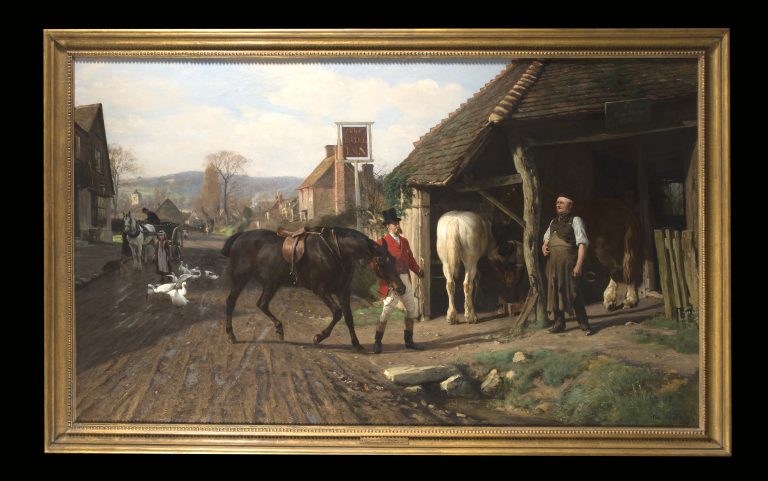
‘He’s cast a shoe!
Oil on canvas
40 x 63 Inches – Signed
Price – Please contact Gallery
Provenance:
Baron J.H. Schroder, by 1887; With L.H. Lefevre;
Private Collection, United Kingdom
Exhibited:
London, Royal Academy, 1877, no 957 Manchester, Royal Jubilee Exhibition, 1887, no 125
Literature:
Royal Academy Notes, 1877, p. 61
Otto Weber was a cosmopolitan artist from Germany and studied in Berlin under Carl Steffeck and also in Paris with Thomas Couture. He specialised in pastoral scenes whose paintings were known across Europe. Between the years of 1863 and 1864 he travelled to Brittany, where he painted romantic scenes depicting the day to day life of the Bretons. Interestingly, Weber was one of the first artists to paint in the Breton village of Pont-Aven, which from the 1850s became an artists’ colony that lasted until the start of the 20th century.
It was in 1864 that he debuted at the Paris Salon with a work titled Noce a Pont-Aven. Weber would continue to exhibit at the Paris Salon until 1869. He won medals at the Salon in both ’64 and ‘69.
When the Franco-Prussian War hit in 1870, Weber had to leave France and travelled to Italy, where he stayed in Rome and Milan. Two years later in 1872, at the request of Queen Victoria, Weber moved to London.
He enjoyed great success in England, producing landscapes, figurative pieces, and hunting scenes from his address at Brignall House, Greville Road, St John’s Wood. He exhibited at the R.A. from 1874 to 1888, as well as at the Old Water-Colour Society and the Grosvenor Gallery.
Weber produced detailed, beautifully executed rural scenes, such as this one, which were a testament to his academic training in Berlin and Paris. Thanks partly no doubt to his nationality, Weber also worked for Queen Victoria and her German relations. He exhibited a portrait of H.H. Prince Christian Victor of Schleswig-Holstein at the R.A. in 1874 and a portrait of Queen Victoria’s Skye Terriers in 1876.
Royal Academy Notes records of the present picture: ‘Huntsman and farrier in dramatic contrast. The steed is ‘Thornton’ belonging to the Prince of Wales; in the huntsman we may recognise the portrait of a not unknown littérateur’. Regretably, the identity of this writer has so far eluded the modern viewer.
